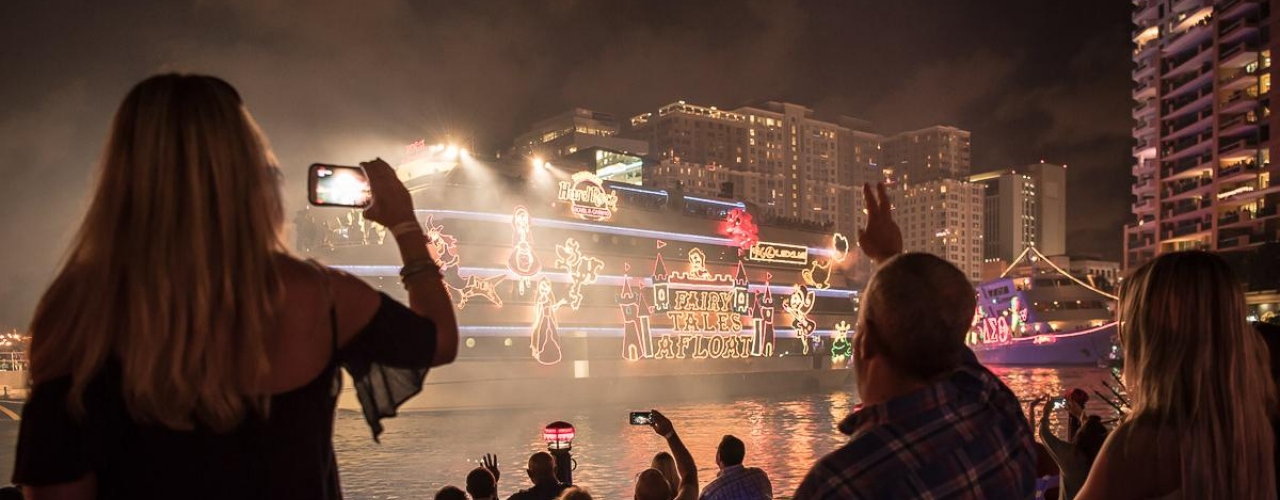
Florida's Holiday Boat Parades - Christmas Boat Parades in FL
Based on an article by Amy Wimmer Schwarb
The same vessels that troll Florida's waters take on blinking lights, animated characters and other holiday decorations during Florida’s holiday boat parades.
DawnMarie Capone and her boyfriend live in Boston, where the holiday season brings a chill to the air and ice and snow to the streets and sidewalks.
But this year, for his 50th birthday, she's introducing him to a different wintertime scene of Christmas boat parades in Florida. They'll travel to Key Largo in December for a lighted boat parade – a tradition that Capone considers a distinct part of Florida culture.
"It's just so different," said Capone, who grew up in Poughkeepsie, N.Y., but lived in Indian Shores and Melbourne, among other Florida locales, for a few years. "Christmas in Florida doesn't look like Christmas everywhere else. That's why it's special."
During Florida's holiday boat parade season, the same vessels that troll the Atlantic, the Gulf and all points in between on warmer days take on blinking lights, animated characters and other holiday decorations for December sojourns that please thousands of fans watching from the banks. Dozens of the state's oceanfront, Gulf-front or riverfront communities host opportunities for local boaters to bring the holiday spirit to the water.
"Boats of all shapes and sizes tend to participate. The best use all things that assault the senses from a visual and sound standpoint," said Gary Guertin, past chairman of the Martin County Convention and Visitors Bureau and producer of Talkin' Tourism, a weekly radio show. "It's just as much about the boat community as people on shore."
A roundup of holiday and Christmas boat parades in Florida is available at FloridaByWater.com, where dozens of communities from Key West to Jacksonville to Pensacola list their holiday boat parade plans. The website's founder, Rusty Gardner of Jacksonville, says he tries to attend a couple boat parades each year and has a few favorites.
"There's a few you would never expect," Gardner said. He pointed out some communities that take their boat parades seriously: Tampa, for instance, sponsors several – one on Dec. 16 and two on Dec. 22. The Florida Keys are home to three or four parades, he said.
Gardner enjoys venturing off the beaten path to discover small holiday and Christmas boat parades in Florida with local flavor. Among his favorites: northwest Florida's RiverWalk Milton, scheduled this year for Dec. 7; and Boat Parade of Lights and Holiday on the Harbor in Carrabelle, a northwest Florida river town.
Another favorite is the Holiday Regatta of Lights in St. Augustine, which will take place at 6 p.m. Dec. 8 in the historic district, overlooking Matanzas Bay.
"You've got the historic city with the Bridge of Lions in the background," Gardner said. "And St. Augustine has a personality all its own."
One of the biggest of Florida’s holiday boat parades is the Seminole Hard Rock Winterfest Boat Parade, also scheduled this year for Dec. 15 in Fort Lauderdale. Called the "greatest show on H2O," the 41-year-old parade has an annual theme and a history of big-name grand marshals such as Shaquille O'Neal.
For those who can't stake out a free vista along the parade route, grandstand seats are available.
"I'm pretty confident in saying they have the biggest and probably one of the best boat parades in the country," said John Kazaliauskas, founder of BoatFlorida.com and a frequent spectator or participant in boat parades around the state. "In general, the ones I've participated in have had something for everybody, so regardless of your age or your culture or your background, it seems to be that everybody has a good time one way or another."
And frankly, Kazaliauskas adds, boaters who decorate their boats for the parades aren't just trying to entertain onlookers; they're also looking for a boating fix.
"It's a good excuse," Kazakiauskas said, "to go boating in the winter and celebrate the holidays."
If You Go
The most complete listing available of Florida boat parades can be found at FloridaByWater.com, where website founder Rusty Gardner maintains a list of events submitted by parade organizers around the state. Be sure to double check listings before you go, as dates and times are subject to change.
Amy Wimmer Schwarb has spent her professional career vacillating between the coasts of Florida and her home state of Indiana, spending several years as a staff writer and editor at the St. Petersburg Times and several more as a magazine editor in Indianapolis. But in the end, Florida won her heart: She is now a full-time freelancer based in St. Augustine.